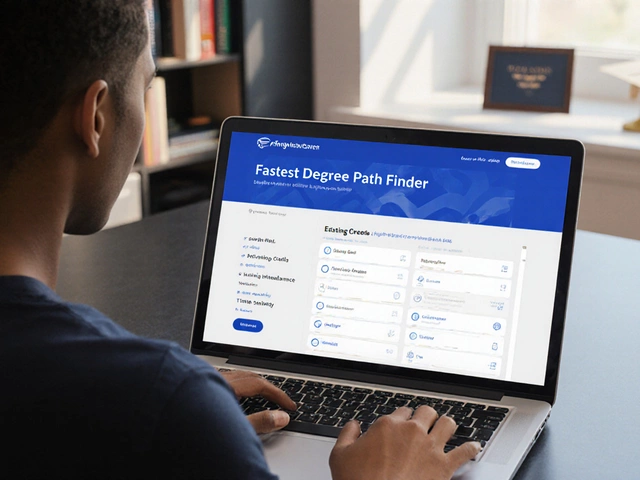There's a word we all know well: balance. In life, balance means keeping things steady, and when it comes to private tutoring, the length of each session is just like that tightrope we all try to walk without swaying too far either way. An overly long tutoring session? A fast ticket to daydreaming. Too short? Before you know it, you're out the door with more questions than when you started.
The key is in finding that sweet spot—where students stay engaged, concepts crystalize, and there's enough time to both absorb and reflect. More than just marking time on a clock, the ideal tutoring session adapts, responds, and breathes with the needs of the learner. So, how do we find this perfect pace?
- The Goldilocks Principle of Session Duration
- Factors Influencing Ideal Tutoring Time
- The Science Behind Attention and Retention
- Adapting Session Length to Student Needs
The Goldilocks Principle of Session Duration
The idea behind the Goldilocks Principle is finding the "just right"—a term borrowed from the beloved fairy tale where Goldilocks seeks out the perfect balance. In private tutoring, the session length isn't different. It's about striking a harmony between productivity and overload, a crucial consideration that ensures both tutor and student maximize their time together.
Tutoring session length hinges on striking this perfect balance. For instance, younger students often thrive in shorter, more succinct sessions. Research suggests that children aged 6 to 10 benefit most from a concentrated 30 to 45-minute period, a timeframe tailor-made to coincide with their developing attention spans.
Why Duration Matters
For older students, particularly those in their teenage years or adults, sessions may stretch to 60 or 90 minutes, accommodating more complex topics without inviting fatigue. But why does this matter so much? Because overstaying the welcome of attention leads to mental drift, where the freshly planted seeds of knowledge struggle to take root.
How does a structured tutoring session length make a difference? It's all about mental endurance. Scientifically, our brains aren't marathoners; they're sprinters. Cognitive psychologists find that intense concentration can lead to burnout and diminishing returns after sustained periods, suggesting that sessions curated to avoid fatigue while still capturing the learner's engagement are key.
Customizing for Success
- For younger students: 30 to 45 minutes
- For high school or adult learners involved in complex subjects: 60 to 90 minutes
- Incorporate short breaks: A breath of mental fresh air every 20 to 30 minutes can work wonders.
Effective tutoring time doesn't subscribe to a one-size-fits-all rule. Variables like the subject complexity, student's learning pace, and individual's attention span dictate how the Goldilocks Principle takes shape in each unique educational setting. Flexibility is the cardinal rule here, because education at any level is as much about adaptation as it is about teaching.
Factors Influencing Ideal Tutoring Time
Determining the perfect length for a tutoring session isn't a one-size-fits-all equation. Several key factors come into play, each shaping the tutoring journey in unique ways. Understanding these influences can create a tailored and effective learning experience, ensuring that every moment is spent wisely.
Maturity and Age of the Student
The age and developmental stage of the learner are crucial in deciding session length. Generally, younger students, such as those in primary school, have shorter attention spans, suggesting that a session lasting around 30 to 45 minutes might be ideal. As students mature, their ability to focus extends, permitting longer sessions of approximately 60 to 90 minutes or more, particularly in secondary education and beyond.
Subject Matter Complexity
It's no secret that the complexity of the subject matter significantly influences private tutoring duration. Delve into a topic like calculus or Shakespearean literature, and the intricacies might require a more extended exploration compared to straightforward multiplication tables or introductory grammar. Tailoring the session to accommodate the depth and breadth of the subject ensures that the student has ample time to digest and interact with new information.
Student's Learning Style
Every student possesses a unique learning style, and recognizing this can further enhance the effectiveness of a tutoring session. Visual learners might benefit from shorter, more visually rich sessions, peppered with diagrams and illustrations. Conversely, auditory learners might excel with longer discussions that explore topics in depth through conversation and dialogue.
Goals and Objectives of the Session
Clear objectives set at the outset can define the appropriate length of the session. A session aimed at completing a single piece of homework might be comfortably short, while one focused on comprehensive test preparation might necessitate a longer timeframe, allowing for cover-to-cover review of necessary materials.
| Factor | Recommended Session Length |
|---|---|
| Primary education | 30-45 minutes |
| Secondary education | 60-90 minutes |
| Simple topics | Shorter sessions (up to 45 minutes) |
| Complex topics | Extended sessions (60-120 minutes) |
Ultimately, the challenge lies in adapting session length to student needs. Flexibility, communication, and constant reassessment are key—like crafting a bespoke suit, it must fit the individual perfectly, providing just enough room for growth and understanding.

The Science Behind Attention and Retention
Dive into the profound realms of the brain, and you'll discover something fascinating: our attention spans are not limitless. In fact, research suggests that the average human adult maintains optimal focus for only about 20 to 30 minutes at a time. It's known as the attention span ceiling, and it's a crucial factor to consider when determining the duration of a tutoring session.
Breaking into those golden windows can be akin to crafting a masterpiece—complex, yet rewarding. With this in mind, the first half-hour of a session could be dedicated to tackling new and challenging material, riding the wave of peak concentration. Once that slope begins to dip, it's wise to shift gears, engaging the student with activities that reinforce understanding. Active learning techniques, such as quizzes or interactive discussions, can keep the mind alert beyond the peak of initial attention.
What Does Cognitive Research Suggest?
The cognitive load theory, a cornerstone of educational psychology, underscores the importance of dosing information in digestible chunks to enhance knowledge retention. Piling on more content than the working memory can handle leads to cognitive overload, which ultimately impairs learning rather than aids it.
Moreover, sleep researchers have long emphasized the stages at which learning solidifies. During breaks or rest periods, our brains engage in a process known as consolidation, where learned information is transferred from short-term to long-term memory. Given this, infusing short breaks or intermissions into tutoring sessions can be a powerful tool for retention.
Incorporating Breaks
How do we best structure these intermissions? Consider short, structured breaks after every 30 minutes of focused learning. This doesn't mean a complete disconnect; rather, engaging the mind in a different type of task can re-energize attention spans without causing them to collapse entirely. Activities as simple as stretching, a quick mental game, or even a brief discussion about an unrelated topic can serve the purpose efficiently.
Empirical Evidence in Educational Settings
Interesting findings from educational settings have shown that students involved in sessions punctuated by breaks perform up to 20% better in later testing compared to their counterparts enduring continuous study periods. This demonstrates the tangible benefits of aligning session lengths with natural cognitive rhythms.
By understanding and applying these insights, a tutoring session transforms from a static block of time into a dynamic, cognitively-rich experience that's attuned to the way our brains work. It's all about maximising efficiency while ensuring students walk away not just informed, but enlightened.
Adapting Session Length to Student Needs
Not all learners are created equal, and neither should the duration of tutoring sessions be a one-size-fits-all kind of affair. Tailoring the length of a tutoring session to suit individual student requirements can maximize engagement and enhance learning outcomes. It's akin to adjusting the sails of a ship to harness the wind perfectly; it necessitates patience, observation, and understanding.
Understanding the Individual Learning Pace
First, assess the student's natural rhythm of understanding. Some students quickly grasp new concepts and are ready to move on, while others need more time to chew over the material. It's helpful to conduct an initial assessment session to gauge attention span and learning speed. A Harvard study noted that "individual differences in learning are profound, and acknowledging them can lead to dramatically improved outcomes."
"Know thy learner and the learning time shall reveal itself," suggests Dr. Clara Thompson, an expert in educational psychology.
Age and Developmental Considerations
Age is a significant factor when determining the ideal tutoring session. Younger learners, especially those in primary school, often have shorter attention spans. Research indicates that early elementary students benefit most from 20 to 30-minute sessions, while secondary level students might comfortably handle 45-minute to 1-hour sessions.
For older students, particularly those in higher education, the tutoring session length can afford to be more flexible. Here, the key lies in achieving a balance between depth and due attention, ensuring that information is neither rushed nor dragged monotonously.
Feedback and Adjustment
The beauty of private tutoring lies in its adaptability. Regular feedback from students can be incredibly valuable. A simple query—'How did this session's length feel for you?'—can guide subsequent sessions. Adjustments might mean moving from a set timeframe to flexible durations depending on the topic's complexity or the student's mood and mental readiness.
Statistical Insight
| Age Group | Recommended Session Duration |
|---|---|
| Primary School | 20-30 minutes |
| Secondary School | 45-60 minutes |
| University Students | 60-90 minutes |
Ultimately, the focus should be less on ticking the clock and more on what each student gains in that time. The most effective approach to session length is one that evolves alongside the learner, making the tutoring experience both enriching and personalized.






